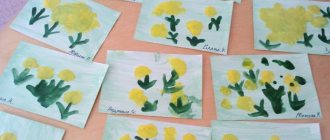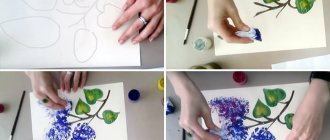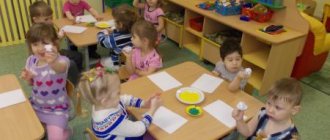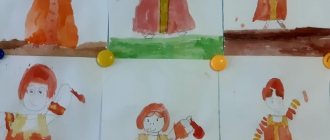Summary of a drawing lesson in the senior group “Be healthy!”
Ulyana Khamadeeva
Summary of a drawing lesson in the senior group “Be healthy!”
Summary of a drawing lesson in the senior group on the topic “ Be healthy !”
Goal: Creating conditions for the development of creative abilities in the process of productive activity.
• teach children to distinguish vitamin-containing foods;
• explain to children how vitamins affect the human body, their benefits and the importance of vitamins for human health ;
• develop attention, thinking, imagination, active and passive vocabulary;
• instill in children a desire to take care of their health .
Preliminary work: conversation with children about health ; preparing worksheets.
Materials: colored pencils, worksheets, sheets of drawing , boxes, jar, Pilyulkin doll.
On the topic: methodological developments, presentations and notes
Summary of a lesson in mathematics with children of the preparatory school group “Journey into the past of hours”
Abstract of the GCD for designing with children of the preparatory school group "Snowflake"
Program content: - Clarify and expand ideas about a snowflake. - Develop observation skills, interest in studying…
Summary of educational activities for children of the senior group
Bilim take salas / Educational area
: "Creation"
Bilim kozderi / Section:
"Drawing"
Aydin
takyryby
/
Theme of the month :
“Growing up healthy”
Aptanyn takyryby
/
Topic of the week:
“We are brave and agile”
Takyryby /
Topic:
“Favorite sport”
Maksaty / Purpose:
Teach children to draw a human figure in motion, observing proportions, conveying the different positions of the arms and legs. Develop artistic abilities. Develop a conscious attitude towards your health.
Korset material/
Demonstration material: illustrations, envelopes.
Sozdik zhumysy
/
Vocabulary work:
Winter and summer sports
Bilingual component
/
Bilingual component:
bass head, dene - body, q ol - hand, ayak - leg.
Organizing time
- IN.:
Guys, do you like to play sports?
What sports do you know?
What sports do you or your family do?
What is your family's favorite sport? (Children's answers)
- Main part
And now I suggest you relax a little and play the game “The sea is agitated - once.” You need to come up with an athlete involved in a certain sport and guess the desired sport.
The sea is agitated - once,
The sea is worried two
The sea is worried three,
Sports figure freeze!
I suggest you play the game
“Guess the sport.”
On the table there are upside-down cards depicting various sports. The child comes up, takes one card, looks at it without showing it to others, and depicts the sport that is drawn in the picture. Children guess the sport and name it.
Physical education minute
V.: I suggest you get up and stretch:
So that we grow strong, dexterous and brave (exercise “Strongman”)
Every morning we do exercises (walking in place)
We raise our hands to the sun, then lower them down, (according to the text)
We squat and stand up and don’t get tired at all. (according to the text)
V.: I think that each of you has a favorite sport. Therefore, I suggest you draw athletes or yourself playing your favorite sport. First, you need to draw a human figure with a simple pencil, pay attention to the varied positions of the athlete’s arms and legs, and the proportions of the body. Then carefully paint, following the outline.
- Creative activities of children
Help from a teacher as needed
- Exhibition of drawings
When the drawing is done, the children come out one by one and talk about their work and their favorite sport.
- Reflective circle
(with a ball)
IN:
Guys, tell me, why do we need to play sports?
- Children's answers (to be healthy, strong, resilient, etc.)
What else did we do in class?
Expected Result:
Know:
human structure.
Name body parts in Russian and Kazakh. language: bass - head, dene - body, q ol - hand, ayak - leg. Have an idea
about winter and summer sports
Be able to:
Draw a human figure in motion, observing proportions, conveying different positions of arms and legs.
Subject:
Sport is health.
Target
: consolidate knowledge about various sports, about the Olympics; teach pantomime to depict familiar sports; develop an interest in various sports, a desire to play sports; improve your plasticine modeling skills.
Progress of the lesson
Guys, we hear the familiar words “physical education” and “sport” every day. What do you think is the difference between these two concepts? (Everyone can do physical education, but not sports.)
Physical education can be done by the small, the old, and the sick. The strongest, strongest and healthiest people go in for sports. But every athlete dreams of becoming an athlete. What needs to be done for this? (You need to do exercises every morning, perform exercises in the open air or with the window open.)
What kind of children are there who don’t like to do exercises and don’t like physical education? (They are weak, often get sick, sad, they don’t succeed in many things in life, they study poorly.)
Show what kind of children these are. (Pantomime "A Very Thin Child")
Don't you want to become such a child? (No.)
Let's do exercises with you and strengthen our muscles. (A set of exercises with musical accompaniment - “One, two, three, come on, repeat!”)
Do you know what the most important competitions for athletes are called? (Olympic Games.) Every athlete dreams of competing and winning them.
Listen to the legend about the origin of the Olympic Games. Rumor associates the origin of the Olympic Games in ancient times with the name of Iphitus, ruler of the region of Olympus. The years of his reign were continually overshadowed by bloody feuds with neighbors. And one day, when another war with Sparta was about to break out, Iphit suggested that the Spartans sheathe their swords and, having made peace, organize athletic competitions in honor of this event, “so that not with weapons and blood, but with strength and dexterity, the greatness of people would be asserted.” . The proposal was accepted, and Olympia forever became a place of peaceful sports battles.
A lot of time has passed. And so in 1896, the Olympic flame flared up again over the capital of Greece, Athens. This is where the calculation of the modern Olympic Games began.
Guys, look at the emblem of the modern Olympic Games. (It is suggested to consider the emblem.) These are the five Olympic rings. What do these rings mean? (Five continents.) This is a sign of unity and friendship among athletes from five continents. The blue ring symbolizes Europe, yellow - Asia, black - Africa, green - Australia, red - America.
Let's find these continents on the globe together. (Children work with a globe.)
So who can participate in the Olympic Games? (The strongest and most prepared athletes in the entire globe.)
What is the symbol of the Olympic Games? (Fire.)
Where is the fire lit? (In Greece on Mount Olympus.)
How is fire delivered to the stadium where the Olympic Games will be held? (The runners deliver the lit torch.)
What Olympic Games are held? (Winter and summer.)
Who is participating in the Winter Olympics? (Winter sports athletes.)
Remember winter sports and draw them. (Children pantomime depict winter sports: hockey, speed skating, figure skating, skiing, luge, ski jumping, etc.)
Who is competing at the Summer Olympics? (Athletes of summer sports.)
Remember and show summer sports.
(Children pantomime depict summer sports: football, rhythmic gymnastics, athletics, wrestling, boxing, swimming, fencing)
Look at these funny pictures. The artist mixed up the sports equipment of the athletes. Try to find and indicate errors. (Children find mistakes and explain what was drawn incorrectly and why.)
Now tell me which sport you liked best. What sport would you like to play? Would you go to the Olympic Games to defend the honor of Russia? (Children talk about the sport they like, sculpt athletes from plasticine, and display them on a model of the stadium.)
Svetlana Lukina
Summary of drawing lesson “We love winter sports”
Drawing notes
in the senior group on the topic “We
love winter sports
”
Goal: to cultivate a love of sports
, learn to convey in
drawing your favorite winter sport
(skaters, hockey players, figure skaters, skiers, highlighting the characteristic features.
Program content: clarify children's knowledge about winter sports
.
Strengthen children's ability to draw
a human figure in motion. Help children establish the relationship between physical activity and a healthy lifestyle. Develop a conscious attitude towards your health. Promote the development of logical thinking, attention, memory.
Sports drawing competition
Every preschool institution can hold the following sports-themed drawing competition:
- Children can draw on any material, whatever they like best on the topic of sports. There is no need to limit children in anything so as not to lose their interest.
- The work may also contain some elements of arts and crafts.
- From each child you can only accept one of the best, in his opinion, work.
When the drawings are ready, they need to be hung in the most visible place, but at the same time difficult for children to reach. Place the ballot box next to the drawings. Let everyone who comes to kindergarten vote. To keep everything fair, do not sign the work on the front side.
Be sure to hold similar competitions in educational institutions in order to promote a healthy lifestyle, develop the creative abilities of children and form the correct model of behavior for each child. Don’t forget to lead by example so that results can be achieved quickly and efficiently!
Preview:
Topic of the week: Healthy. Healthy lifestyle Sport
Notes on drawing in the preparatory group on the topic: “Gym. Athlete"
1. Introductory part. The teacher asks a riddle about sports:
- Who lifts dumbbells?
Does he throw the cannonball the furthest?
— What sports do you know? (children list... There are a lot of sports: swimming, jumping, running, wrestling, tennis, hockey, football, basketball, golf, volleyball, throwing, gymnastics)
— Why do people play sports? (To be strong, agile, strong, healthy)
- Who runs at full speed,
Drawing about sports in pencil, step by step
Drawings about sports are not only images of sports attributes, they are also people who have achieved great success in sports. We invite you to draw a champion boxer:
- We sketch out the main elements in the figure - these are parts of the body:
- Draw the athlete's face. Here you need to remember the main rule - the person’s nose is drawn clearly in the center in relation to the eyebrow line and chin. In other words, the nose is the point of intersection of lines, the extreme points of which are the eyebrows and chin:
- After this, we begin drawing the lines of the body. Since this is an athlete, you need to draw every muscle and line in detail:
- Only shadows remain on the body. They are necessary so that, looking at the drawing, emotions are evoked:
Drawing a sport, step by step
Option #1: Snowboarding
- First we draw the snow itself. This is a regular board rounded at both edges. It should be slightly tilted to give the impression that the athlete is performing some kind of maneuver in the drawing. You need to immediately draw the head; it is located at the same level as the upper edge of the snowboard. Please note that the athlete’s legs should also be slightly visible.
- Draw the shins. The athlete’s legs will not be completely visible, since in the picture he is depicted in a “half-sitting” position.
- We round the knees and draw a helmet with a mask on the head.
- We sketch out the markings of how the shoulders and arms should be positioned. Note that one hand is free, which will reflect how the athlete maintains balance, and with the other he holds on to the snowboard.
- We detail the drawing - add facial features and clothing elements.
Option #2: Speed skating
- First, we draw the skater’s body using ordinary lines and simple geometric shapes.
- We add additional lines to the lines indicating the athlete’s body so that the arms and legs are clearly distinguished. At the same stage we draw the hat, nose and mouth.
- We add eyes on the face, draw ears, as well as lines on the tracksuit of the hero we are portraying. We also draw the skates with simple lines so that their frame is clearly visible.
- We detail the drawing with different elements, and then color it at our discretion.
Drawings about sports, step by step
Option #1: Gymnast
- We draw several approximately identical circles on the sheet. They should be located in one line at a slight angle.
- We depict the contours of the gymnast’s body and the hands with which she holds the ball. Everything should look schematic at this stage:
- Now the contours need to be shaped:
- When all parts of the body are clearly marked, draw a bold pencil on the face, arms, legs and torso. We also draw the gymnast’s hair:
- Add shadows to the drawing and remove all unnecessary lines:
Option #2: Skier
- We make sketches of the geometric shapes of a person who is standing on skis in a “half-sitting” position:
- Next you need to draw the skier’s suit, his helmet with boots and, of course, his skis:
- Now on the costume you need to draw shading and other elements that you consider necessary:
- All that remains is to shade in the right places and the skier is ready:




